Decline in Ice Coverage and Ice-Free Period Extension in the Kara and Laptev Seas during 1979–2022
Abstract
1. Introduction
2. Materials and Methods
2.1. Study Area
2.2. Sea Ice Concentration Data
2.3. Ice-Free Period Detection Procedure
3. Results
3.1. Sea Ice Extent Decline
3.2. Frequency of Annual Sea Ice Retreat
3.3. Regional Distribution of LTM for DOR, DOA, and IFP
3.4. Trends in DOR, DOA, and IFP during 1979–2022
4. Discussion
5. Summary and Conclusions
Author Contributions
Funding
Data Availability Statement
Acknowledgments
Conflicts of Interest
References
- Comiso, J.C.; Parkinson, C.L.; Gersten, R.; Stock, L. Accelerated Decline in the Arctic Sea Ice Cover. Geophys. Res. Lett. 2008, 35, 2007GL031972. [Google Scholar] [CrossRef]
- Stroeve, J.; Holland, M.M.; Meier, W.; Scambos, T.; Serreze, M. Arctic Sea Ice Decline: Faster than Forecast. Geophys. Res. Lett. 2007, 34, 2007GL029703. [Google Scholar] [CrossRef]
- Stroeve, J.C.; Serreze, M.C.; Holland, M.M.; Kay, J.E.; Malanik, J.; Barrett, A.P. The Arctic’s Rapidly Shrinking Sea Ice Cover: A Research Synthesis. Clim. Chang. 2012, 110, 1005–1027. [Google Scholar] [CrossRef]
- Vihma, T. Effects of Arctic Sea Ice Decline on Weather and Climate: A Review. Surv. Geophys. 2014, 35, 1175–1214. [Google Scholar] [CrossRef]
- Gao, Y.; Sun, J.; Li, F.; He, S.; Sandven, S.; Yan, Q.; Zhang, Z.; Lohmann, K.; Keenlyside, N.; Furevik, T.; et al. Arctic Sea Ice and Eurasian Climate: A Review. Adv. Atmos. Sci. 2015, 32, 92–114. [Google Scholar] [CrossRef]
- Zhang, R. Mechanisms for Low-Frequency Variability of Summer Arctic Sea Ice Extent. Proc. Natl. Acad. Sci. USA 2015, 112, 4570–4575. [Google Scholar] [CrossRef] [PubMed]
- Stroeve, J.; Notz, D. Changing State of Arctic Sea Ice across All Seasons. Environ. Res. Lett. 2018, 13, 103001. [Google Scholar] [CrossRef]
- Liu, Z.; Risi, C.; Codron, F.; Jian, Z.; Wei, Z.; He, X.; Poulsen, C.J.; Wang, Y.; Chen, D.; Ma, W.; et al. Atmospheric Forcing Dominates Winter Barents-Kara Sea Ice Variability on Interannual to Decadal Time Scales. Proc. Natl. Acad. Sci. USA 2022, 119, e2120770119. [Google Scholar] [CrossRef]
- Deser, C.; Teng, H. Evolution of Arctic Sea Ice Concentration Trends and the Role of Atmospheric Circulation Forcing, 1979–2007. Geophys. Res. Lett. 2008, 35, 2007GL032023. [Google Scholar] [CrossRef]
- Kay, J.E.; Holland, M.M.; Jahn, A. Inter-annual to Multi-decadal Arctic Sea Ice Extent Trends in a Warming World. Geophys. Res. Lett. 2011, 38, 2011GL048008. [Google Scholar] [CrossRef]
- Cavalieri, D.J.; Parkinson, C.L. Arctic Sea Ice Variability and Trends, 1979–2010. Cryosphere 2012, 6, 881–889. [Google Scholar] [CrossRef]
- Serreze, M.C.; Stroeve, J. Arctic Sea Ice Trends, Variability and Implications for Seasonal Ice Forecasting. Phil. Trans. R. Soc. A 2015, 373, 20140159. [Google Scholar] [CrossRef] [PubMed]
- Wang, Y.; Bi, H.; Huang, H.; Liu, Y.; Liu, Y.; Liang, X.; Fu, M.; Zhang, Z. Satellite-Observed Trends in the Arctic Sea Ice Concentration for the Period 1979–2016. J. Ocean. Limnol. 2019, 37, 18–37. [Google Scholar] [CrossRef]
- Francis, J.A.; Hunter, E. Changes in the Fabric of the Arctic’s Greenhouse Blanket. Environ. Res. Lett. 2007, 2, 045011. [Google Scholar] [CrossRef]
- Polyakov, I.V.; Walsh, J.E.; Kwok, R. Recent Changes of Arctic Multiyear Sea Ice Coverage and the Likely Causes. Bull. Amer. Meteor. Soc. 2012, 93, 145–151. [Google Scholar] [CrossRef]
- Screen, J.A.; Simmonds, I. Declining Summer Snowfall in the Arctic: Causes, Impacts and Feedbacks. Clim. Dyn. 2012, 38, 2243–2256. [Google Scholar] [CrossRef]
- Kapsch, M.-L.; Graversen, R.G.; Tjernström, M. Springtime Atmospheric Energy Transport and the Control of Arctic Summer Sea-Ice Extent. Nat. Clim. Chang. 2013, 3, 744–748. [Google Scholar] [CrossRef]
- Olonscheck, D.; Mauritsen, T.; Notz, D. Arctic Sea-Ice Variability Is Primarily Driven by Atmospheric Temperature Fluctuations. Nat. Geosci. 2019, 12, 430–434. [Google Scholar] [CrossRef]
- Graversen, R.G.; Wang, M. Polar Amplification in a Coupled Climate Model with Locked Albedo. Clim. Dyn. 2009, 33, 629–643. [Google Scholar] [CrossRef]
- Screen, J.A.; Simmonds, I. The Central Role of Diminishing Sea Ice in Recent Arctic Temperature Amplification. Nature 2010, 464, 1334–1337. [Google Scholar] [CrossRef]
- Flanner, M.G.; Shell, K.M.; Barlage, M.; Perovich, D.K.; Tschudi, M.A. Radiative Forcing and Albedo Feedback from the Northern Hemisphere Cryosphere between 1979 and 2008. Nat. Geosci. 2011, 4, 151–155. [Google Scholar] [CrossRef]
- Sedlar, J.; Tjernström, M.; Mauritsen, T.; Shupe, M.D.; Brooks, I.M.; Persson, P.O.G.; Birch, C.E.; Leck, C.; Sirevaag, A.; Nicolaus, M. A Transitioning Arctic Surface Energy Budget: The Impacts of Solar Zenith Angle, Surface Albedo and Cloud Radiative Forcing. Clim. Dyn. 2011, 37, 1643–1660. [Google Scholar] [CrossRef]
- Serreze, M.C.; Barry, R.G. Processes and Impacts of Arctic Amplification: A Research Synthesis. Glob. Planet. Chang. 2011, 77, 85–96. [Google Scholar] [CrossRef]
- Cohen, J.; Zhang, X.; Francis, J.; Jung, T.; Kwok, R.; Overland, J.; Ballinger, T.J.; Bhatt, U.S.; Chen, H.W.; Coumou, D.; et al. Divergent Consensuses on Arctic Amplification Influence on Midlatitude Severe Winter Weather. Nat. Clim. Chang. 2020, 10, 20–29. [Google Scholar] [CrossRef]
- Previdi, M.; Smith, K.L.; Polvani, L.M. Arctic Amplification of Climate Change: A Review of Underlying Mechanisms. Environ. Res. Lett. 2021, 16, 093003. [Google Scholar] [CrossRef]
- Duan, C.; Dong, S.; Xie, Z.; Wang, Z. Temporal Variability and Trends of Sea Ice in the Kara Sea and Their Relationship with Atmospheric Factors. Polar Sci. 2019, 20, 136–147. [Google Scholar] [CrossRef]
- Belchansky, G.I.; Mordvintsev, I.N.; Ovchinnikov, G.K.; Douglas, D.C. Assessing Trends in Arctic Sea-Ice Distribution in the Barents and Kara Seas Using the Kosmos–Okean Satellite Series. Polar Rec. 1995, 31, 129–134. [Google Scholar] [CrossRef]
- Ahn, J.; Hong, S.; Cho, J.; Lee, Y.-W.; Lee, H. Statistical Modeling of Sea Ice Concentration Using Satellite Imagery and Climate Reanalysis Data in the Barents and Kara Seas, 1979–2012. Remote Sens. 2014, 6, 5520–5540. [Google Scholar] [CrossRef]
- Kumar, A.; Yadav, J.; Mohan, R. Spatio-Temporal Change and Variability of Barents-Kara Sea Ice, in the Arctic: Ocean and Atmospheric Implications. Sci. Total Environ. 2021, 753, 142046. [Google Scholar] [CrossRef]
- Dong, C.; Nie, H.; Luo, X.; Wei, H.; Zhao, W. Mechanisms for the Link between Onset and Duration of Open Water in the Kara Sea. Acta Oceanol. Sin. 2021, 40, 119–128. [Google Scholar] [CrossRef]
- Wang, S.; Nath, D.; Chen, W. Nonstationary Relationship between Sea Ice over Kara–Laptev Seas during August–September and Ural Blocking in the Following Winter. Int. J. Climatol. 2021, 41, E1608–E1622. [Google Scholar] [CrossRef]
- Bareiss, J.; Gorgen, K. Spatial and Temporal Variability of Sea Ice in the Laptev Sea: Analyses and Review of Satellite Passive-Microwave Data and Model Results, 1979 to 2002. Glob. Planet. Chang. 2005, 48, 28–54. [Google Scholar] [CrossRef]
- Selyuzhenok, V.; Krumpen, T.; Mahoney, A.; Janout, M.; Gerdes, R. Seasonal and Interannual Variability of Fast Ice Extent in the Southeastern L Aptev S Ea between 1999 and 2013. JGR Oceans 2015, 120, 7791–7806. [Google Scholar] [CrossRef]
- Rehder, Z.; Niederdrenk, A.L.; Kaleschke, L.; Kutzbach, L. Analyzing Links between Simulated Laptev Sea Sea Ice and Atmospheric Conditions over Adjoining Landmasses Using Causal-Effect Networks. Cryosphere 2020, 14, 4201–4215. [Google Scholar] [CrossRef]
- Peng, G.; Meier, W.N. Temporal and Regional Variability of Arctic Sea-Ice Coverage from Satellite Data. Ann. Glaciol. 2018, 59, 191–200. [Google Scholar] [CrossRef]
- Bliss, A.C.; Anderson, M.R. Arctic Sea Ice Melt Onset Timing From Passive Microwave-Based and Surface Air Temperature-Based Methods. JGR Atmos. 2018, 123, 9063–9080. [Google Scholar] [CrossRef]
- Meier, W.N.; Stroeve, J.; Fetterer, F. Whither Arctic Sea Ice? A Clear Signal of Decline Regionally, Seasonally and Extending beyond the Satellite Record. Ann. Glaciol. 2007, 46, 428–434. [Google Scholar] [CrossRef]
- Meier, W.; Fetterer, F.; Windnagel, A.; Stewart, S. NOAA/NSIDC Climate Data Record of Passive Microwave Sea Ice Concentration, Version 4 [Data Set]; National Snow and Ice Data Center: Boulder, CO, USA, 2021. [Google Scholar] [CrossRef]
- Cavalieri, D.J.; Gloersen, P.; Campbell, W.J. Determination of Sea Ice Parameters with the NIMBUS 7 SMMR. J. Geophys. Res. 1984, 89, 5355–5369. [Google Scholar] [CrossRef]
- Comiso, J.C. Characteristics of Arctic Winter Sea Ice from Satellite Multispectral Microwave Observations. J. Geophys. Res. 1986, 91, 975–994. [Google Scholar] [CrossRef]
- Fetterer, F.; Knowles, K.; Meier, W.N.; Savoie, M.; Windnagel, A.K. Sea Ice Index, Version 3 [Data Set]; National Snow and Ice Data Center: Boulder, CO, USA, 2017. [Google Scholar] [CrossRef]
- Matthews, J.L.; Peng, G.; Meier, W.N.; Brown, O. Sensitivity of Arctic Sea Ice Extent to Sea Ice Concentration Threshold Choice and Its Implication to Ice Coverage Decadal Trends and Statistical Projections. Remote Sens. 2020, 12, 807. [Google Scholar] [CrossRef]
- JCOMM Expert Team on Sea Ice. SIGRID-3: A Vector Archive Format for Sea Ice Georeferenced Information and Data; Version 3.0; WMO & IOC: Geneva, Switzerland, 2014; 40p, (WMO TD: 1214), (JCOMM Technical Report, 23). [Google Scholar] [CrossRef]
- Afanasyeva, E.V.; Alekseeva, T.A.; Sokolova, J.V.; Demchev, D.M.; Chufarova, M.S.; Bychenkov, Y.D.; Devyataev, O.S. AARI methodology for sea ice charts composition. Russ. Arct. 2019, 7, 5–20. [Google Scholar] [CrossRef]
- Peng, G.; Steele, M.; Bliss, A.; Meier, W.; Dickinson, S. Temporal Means and Variability of Arctic Sea Ice Melt and Freeze Season Climate Indicators Using a Satellite Climate Data Record. Remote Sens. 2018, 10, 1328. [Google Scholar] [CrossRef]
- Bliss, A.C.; Steele, M.; Peng, G.; Meier, W.N.; Dickinson, S. Regional Variability of Arctic Sea Ice Seasonal Change Climate Indicators from a Passive Microwave Climate Data Record. Environ. Res. Lett. 2019, 14, 045003. [Google Scholar] [CrossRef]
- Comiso, J.C. A Rapidly Declining Perennial Sea Ice Cover in the Arctic. Geophys. Res. Lett. 2002, 29, 17-1–17-4. [Google Scholar] [CrossRef]
- Steele, M.; Dickinson, S.; Zhang, J.; Lindsay, R.W. Seasonal Ice Loss in the Beaufort Sea: Toward Synchrony and Prediction. JGR Oceans 2015, 120, 1118–1132. [Google Scholar] [CrossRef]
- Lavergne, T.; Sørensen, A.M.; Kern, S.; Tonboe, R.; Notz, D.; Aaboe, S.; Bell, L.; Dybkjær, G.; Eastwood, S.; Gabarro, C.; et al. Version 2 of the EUMETSAT OSI SAF and ESA CCI Sea-Ice Concentration Climate Data Records. Cryosphere 2019, 13, 49–78. [Google Scholar] [CrossRef]
- Ivanov, V.V.; Alekseev, V.A.; Alekseeva, T.A.; Koldunov, N.V.; Repina, I.A.; Smirnov, A.V. Is Arctic Ice Cover Becoming Seasonal? Issled. Zemli Iz Kosmosa 2013, 4, 50–65. [Google Scholar] [CrossRef]
- Dumanskaya, I.O. Ice Conditions in the Seas of the Asian Part of Russia; IG SOTsIN: Obninsk, Russia, 2017; ISBN 978-5-9908623-6-4. [Google Scholar]
- Dumanskaya, I.O. Ice Conditions in the Seas of the European Part of Russia; IG SOTsIN: Obninsk, Russia, 2014; ISBN 978-5-91070-064-6. [Google Scholar]
- Winsor, P.; Björk, G. Polynya Activity in the Arctic Ocean from 1958 to 1997. J. Geophys. Res. 2000, 105, 8789–8803. [Google Scholar] [CrossRef]
- Isaksen, K.; Nordli, Ø.; Ivanov, B.; Køltzow, M.A.Ø.; Aaboe, S.; Gjelten, H.M.; Mezghani, A.; Eastwood, S.; Førland, E.; Benestad, R.E.; et al. Exceptional Warming over the Barents Area. Sci. Rep. 2022, 12, 9371. [Google Scholar] [CrossRef]
- Kozlov, I.E.; Kopyshov, I.O.; Frey, D.I.; Morozov, E.G.; Medvedev, I.P.; Shiryborova, A.I.; Silvestrova, K.P.; Gavrikov, A.V.; Ezhova, E.A.; Soloviev, D.M.; et al. Multi-Sensor Observations Reveal Large-Amplitude Nonlinear Internal Waves in the Kara Gates, Arctic Ocean. Remote Sens. 2023, 15, 5769. [Google Scholar] [CrossRef]
- Osadchiev, A.; Viting, K.; Frey, D.; Demeshko, D.; Dzhamalova, A.; Nurlibaeva, A.; Gordey, A.; Krechik, V.; Spivak, E.; Semiletov, I.; et al. Structure and Circulation of Atlantic Water Masses in the St. Anna Trough in the Kara Sea. Front. Mar. Sci. 2022, 9, 915674. [Google Scholar] [CrossRef]
- Dmitrenko, I.; Tyshko, K.; Kirillov, S.; Eicken, H.; Holemann, J.; Kassens, H. Impact of Flaw Polynyas on the Hydrography of the Laptev Sea. Glob. Planet. Chang. 2005, 48, 9–27. [Google Scholar] [CrossRef]
- Yamagami, Y.; Watanabe, M.; Mori, M.; Ono, J. Barents-Kara Sea-Ice Decline Attributed to Surface Warming in the Gulf Stream. Nat. Commun. 2022, 13, 3767. [Google Scholar] [CrossRef] [PubMed]
- Steele, M.; Dickinson, S. The Phenology of Arctic Ocean Surface Warming. JGR Oceans 2016, 121, 6847–6861. [Google Scholar] [CrossRef] [PubMed]
- Magritsky, D.V.; Vasilenko, A.N.; Frolova, N.L.; Shevchenko, A.I. Temporal and Spatial Patterns of Changes in Thermal Regime of the Rivers in the Northeast of the Asian Part of Russia. 1. Assessment of Changes in the Water Temperature. Water Resour. 2023, 50, 190–201. [Google Scholar] [CrossRef]
- Magritsky, D.V.; Vasilenko, A.N.; Frolova, N.L. Temporal and Spatial Patterns of Changes in Thermal Regime of the Rivers in the Northeast of the Asian Part of Russia. 2. Changes in the Heat Flux. Water Resour. 2023, 50, 202–214. [Google Scholar] [CrossRef]
- Osadchiev, A.A.; Frey, D.I.; Shchuka, S.A.; Tilinina, N.D.; Morozov, E.G.; Zavialov, P.O. Structure of the Freshened Surface Layer in the Kara Sea During Ice-Free Periods. JGR Oceans 2021, 126, e2020JC016486. [Google Scholar] [CrossRef]
- Osadchiev, A.; Frey, D.; Spivak, E.; Shchuka, S.; Tilinina, N.; Semiletov, I. Structure and Inter-Annual Variability of the Freshened Surface Layer in the Laptev and East-Siberian Seas During Ice-Free Periods. Front. Mar. Sci. 2021, 8, 735011. [Google Scholar] [CrossRef]
- Osadchiev, A.; Zabudkina, Z.; Rogozhin, V.; Frey, D.; Gordey, A.; Spivak, E.; Salyuk, A.; Semiletov, I.; Sedakov, R. Structure of the Ob-Yenisei Plume in the Kara Sea Shortly before Autumn Ice Formation. Front. Mar. Sci. 2023, 10, 1129331. [Google Scholar] [CrossRef]
- Osadchiev, A.; Sedakov, R.; Frey, D.; Gordey, A.; Rogozhin, V.; Zabudkina, Z.; Spivak, E.; Kuskova, E.; Sazhin, A.; Semiletov, I. Intense Zonal Freshwater Transport in the Eurasian Arctic during Ice-Covered Season Revealed by in Situ Measurements. Sci. Rep. 2023, 13, 16508. [Google Scholar] [CrossRef]
- Polyakov, I.V.; Alkire, M.B.; Bluhm, B.A.; Brown, K.A.; Carmack, E.C.; Chierici, M.; Danielson, S.L.; Ellingsen, I.; Ershova, E.A.; Gårdfeldt, K.; et al. Borealization of the Arctic Ocean in Response to Anomalous Advection From Sub-Arctic Seas. Front. Mar. Sci. 2020, 7, 491. [Google Scholar] [CrossRef]
- Willmes, S.; Heinemann, G.; Schnaase, F. Patterns of Wintertime Arctic Sea-Ice Leads and Their Relation to Winds and Ocean Currents. Cryosphere 2023, 17, 3291–3308. [Google Scholar] [CrossRef]
- Ogorodov, S.; Aleksyutina, D.; Baranskaya, A.; Shabanova, N.; Shilova, O. Coastal Erosion of the Russian Arctic: An Overview. J. Coast. Res. 2020, 95, 599. [Google Scholar] [CrossRef]



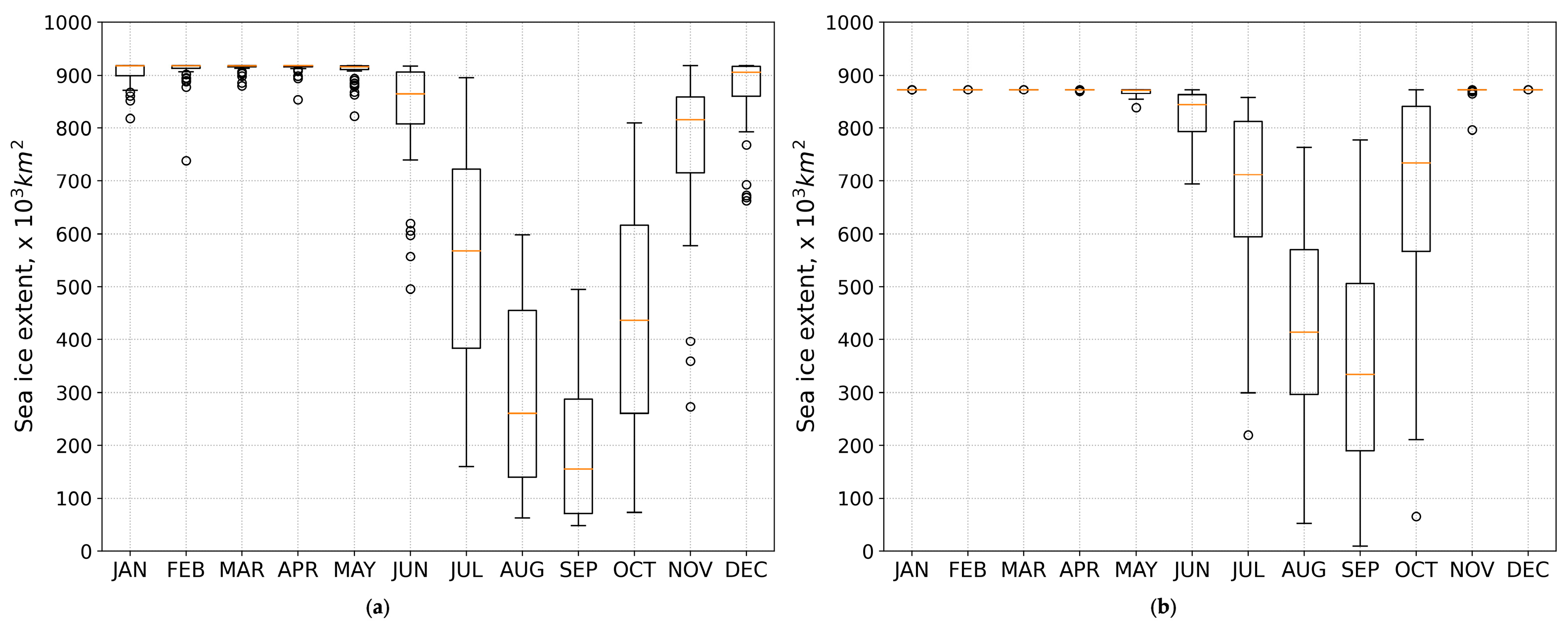
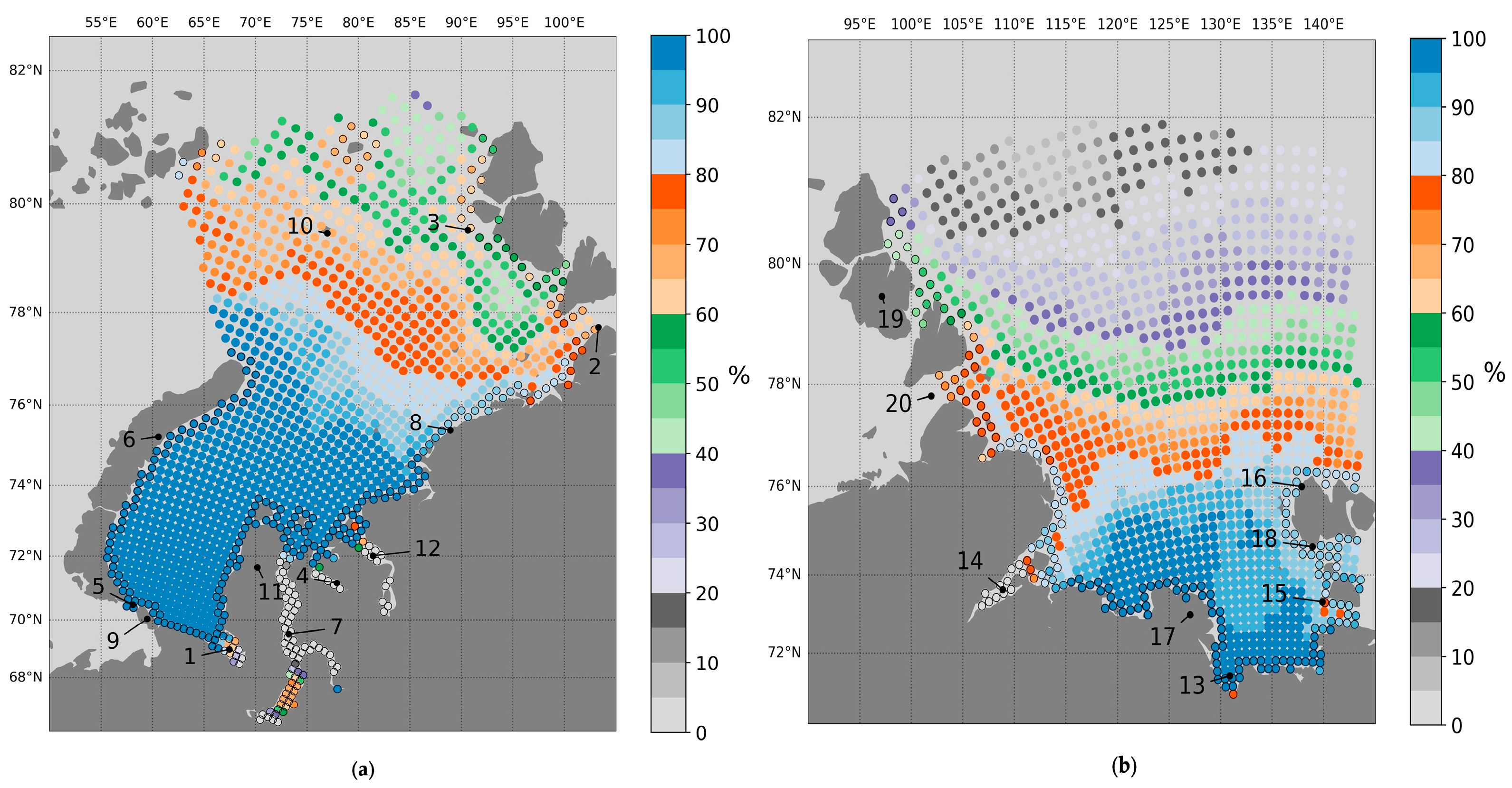
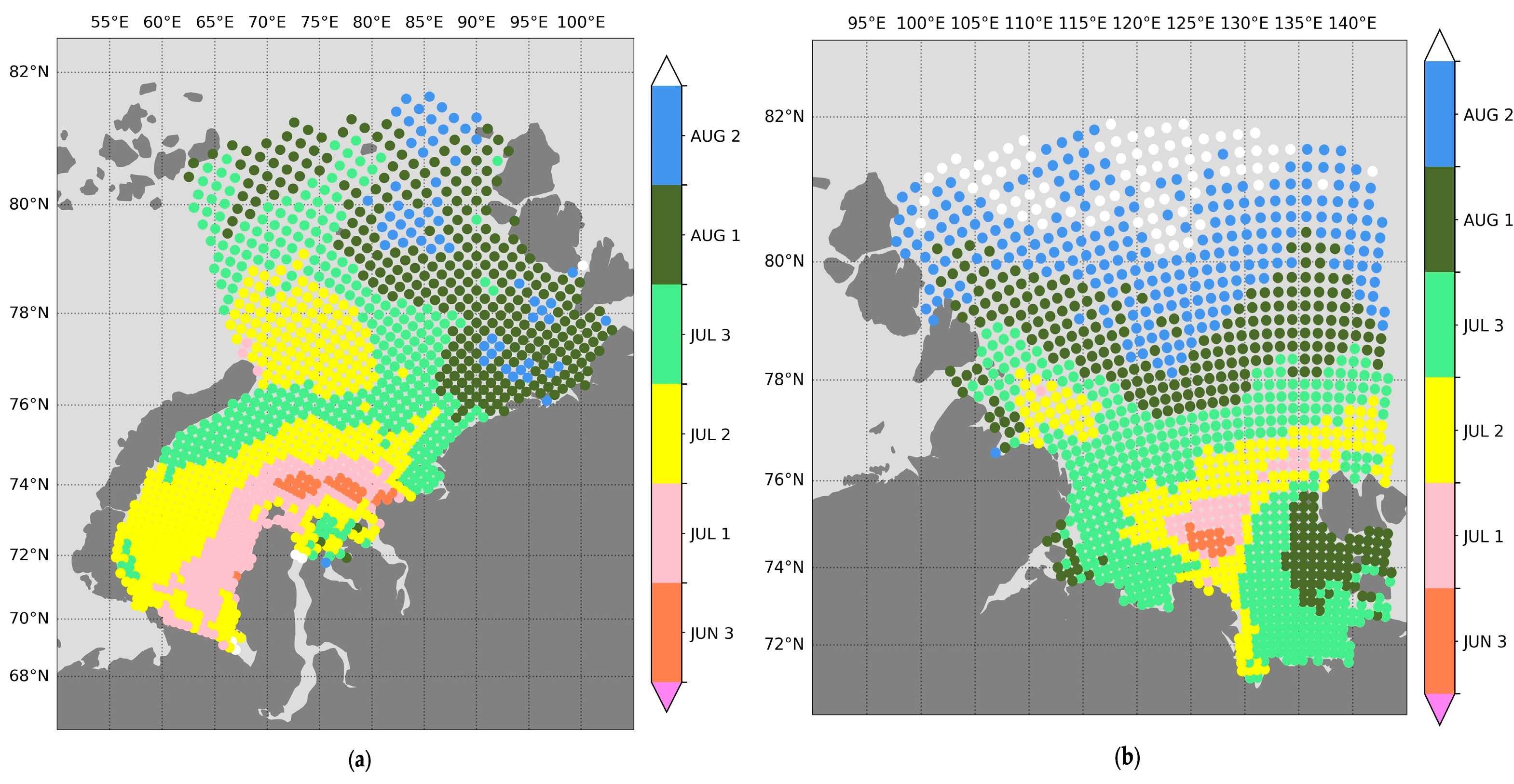

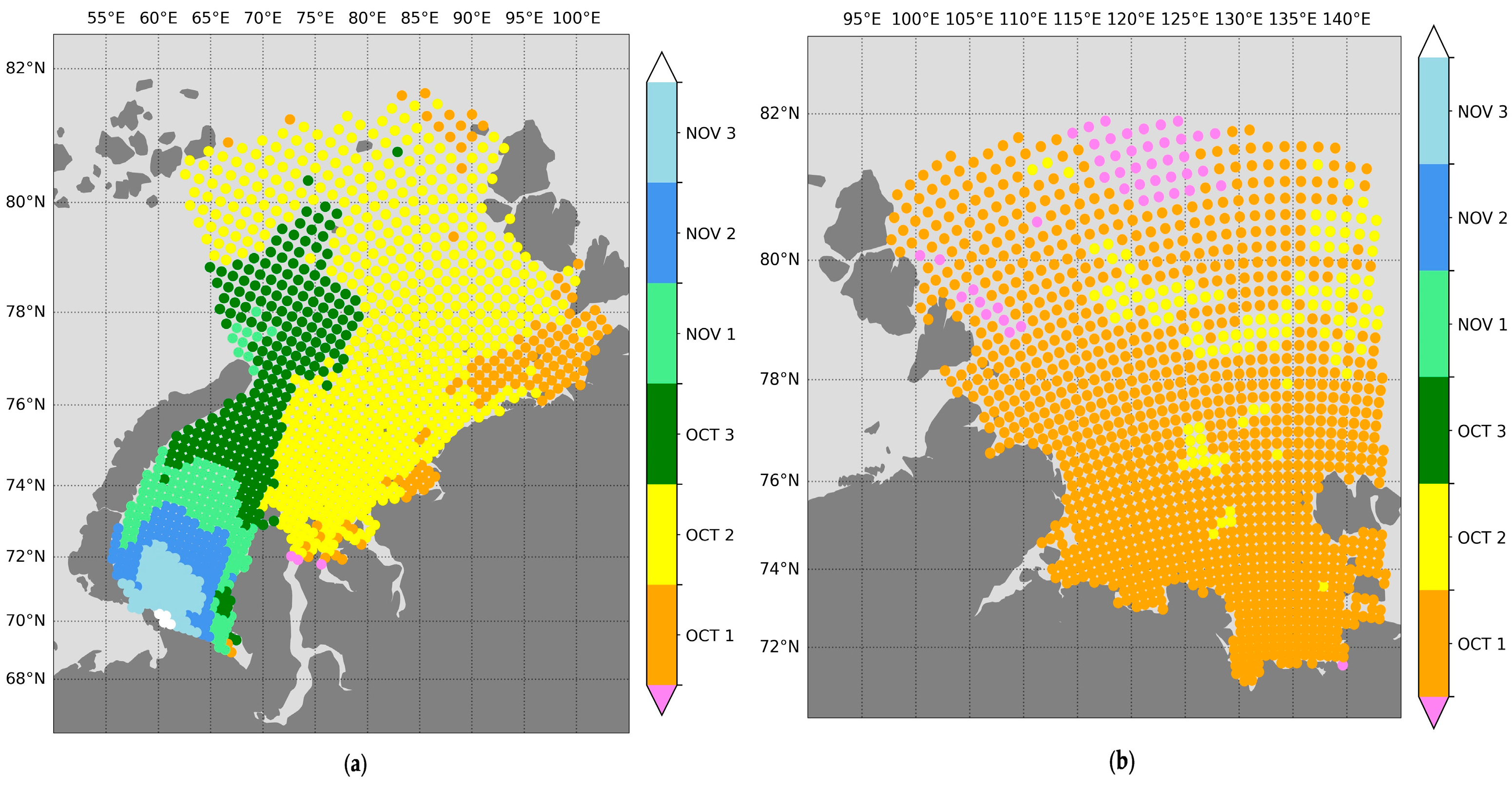
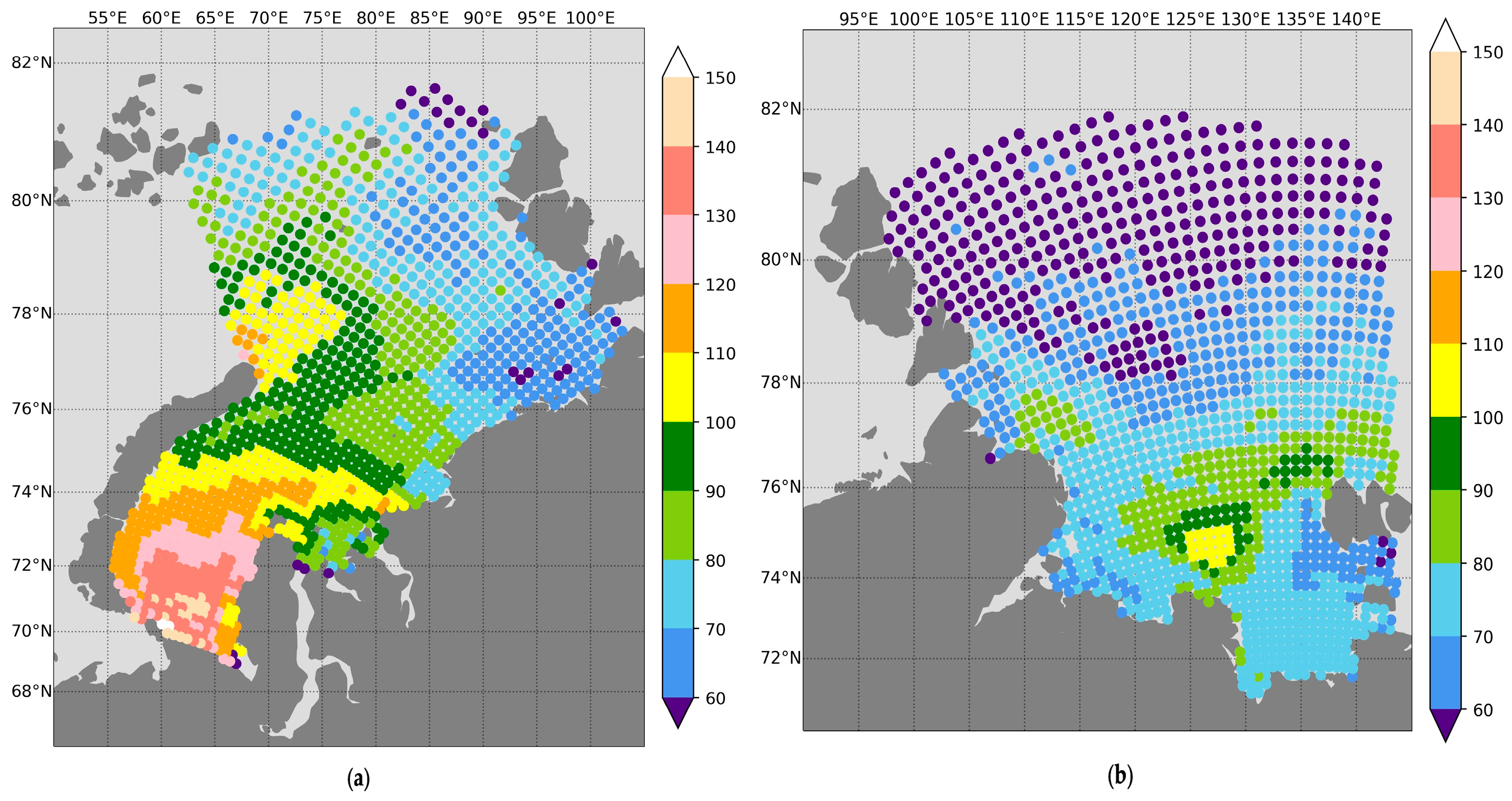
| IFP, Days | DOA | DOR | ||||
|---|---|---|---|---|---|---|
| Kara | Laptev | Kara | Laptev | Kara | Laptev | |
| Mean | 94 | 69 | 24 October | 8 October | 22 July | 31 July |
| Standard deviation | 22 | 13 | 13 | 3 | 11 | 12 |
| Minimum | 33 | 28 | 24 September | 22 September | 25 June | 26 June |
| Q1, 25% | 77 | 61 | 14 October | 6 October | 15 July | 23 July |
| Q2, 50% | 91 | 71 | 19 October | 8 October | 21 July | 30 July |
| Q3, 75% | 109 | 77 | 30 October | 10 October | 1 August | 9 August |
| Maximum | 151 | 107 | 4 December | 16 October | 23 August | 29 August |
| IFP | DOA | DOR | ||||
|---|---|---|---|---|---|---|
| Kara | Laptev | Kara | Laptev | Kara | Laptev | |
| Mean | 20.2 | 16.0 | 8.7 | 6.7 | −11.9 | −9.5 |
| Standard deviation | 5.0 | 4.3 | 2.4 | 2.2 | 3.2 | 2.8 |
| Minimum | −17.5 | 6.8 | 4.1 | 1.6 | −22.7 | −23.4 |
| 25% | 17.2 | 12.3 | 7.1 | 5.1 | −13.5 | −11.3 |
| 50% | 19.9 | 16.3 | 8.8 | 6.7 | −11.3 | −9.5 |
| 75% | 22.9 | 19.0 | 10.1 | 7.9 | −9.9 | −7.0 |
| Maximum | 39.8 | 35.6 | 23.1 | 13.3 | 12.8 | −3.8 |
Disclaimer/Publisher’s Note: The statements, opinions and data contained in all publications are solely those of the individual author(s) and contributor(s) and not of MDPI and/or the editor(s). MDPI and/or the editor(s) disclaim responsibility for any injury to people or property resulting from any ideas, methods, instructions or products referred to in the content. |
© 2024 by the authors. Licensee MDPI, Basel, Switzerland. This article is an open access article distributed under the terms and conditions of the Creative Commons Attribution (CC BY) license (https://creativecommons.org/licenses/by/4.0/).
Share and Cite
Shabanov, P.; Osadchiev, A.; Shabanova, N.; Ogorodov, S. Decline in Ice Coverage and Ice-Free Period Extension in the Kara and Laptev Seas during 1979–2022. Remote Sens. 2024, 16, 1875. https://doi.org/10.3390/rs16111875
Shabanov P, Osadchiev A, Shabanova N, Ogorodov S. Decline in Ice Coverage and Ice-Free Period Extension in the Kara and Laptev Seas during 1979–2022. Remote Sensing. 2024; 16(11):1875. https://doi.org/10.3390/rs16111875
Chicago/Turabian StyleShabanov, Pavel, Alexander Osadchiev, Natalya Shabanova, and Stanislav Ogorodov. 2024. "Decline in Ice Coverage and Ice-Free Period Extension in the Kara and Laptev Seas during 1979–2022" Remote Sensing 16, no. 11: 1875. https://doi.org/10.3390/rs16111875
APA StyleShabanov, P., Osadchiev, A., Shabanova, N., & Ogorodov, S. (2024). Decline in Ice Coverage and Ice-Free Period Extension in the Kara and Laptev Seas during 1979–2022. Remote Sensing, 16(11), 1875. https://doi.org/10.3390/rs16111875








